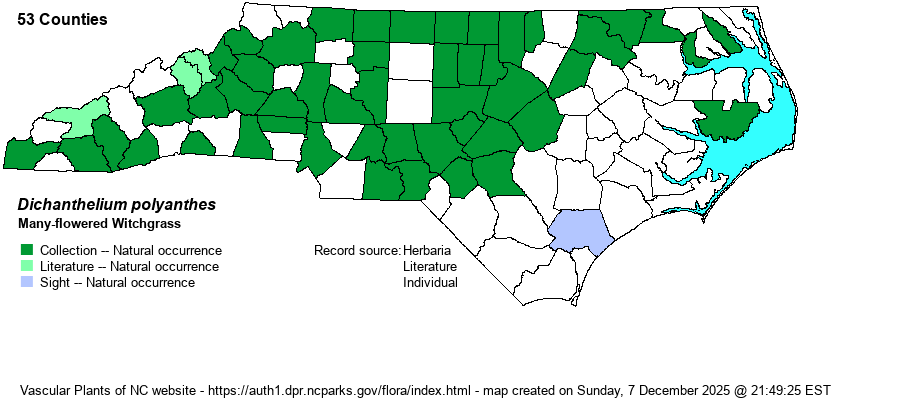| Author | (J.A. Schultes) Mohlenbrock | |
| Distribution | Low Mountains, Piedmont, and northern Coastal Plain; rare in the Sandhills proper.
CT and NY to southern IN and MO, south to southern GA and eastern TX. Records from MA prove to be D. sphaerocarpon. | |
| Abundance | Frequent to common in the Mountains and Piedmont; rare in the Sandhills and Coastal Plain, where limited mainly to counties near the VA line. | |
| Habitat | Primarily a species of brownwater creeksides, streamsides, and gravel bars, but only marginally in large floodplains. Sometimes occurs in roadside ditches. | |
| Phenology | Flowering and fruiting June-October. | |
| Identification | This is a rather elegant witchgrass, 1.5-2.5 feet tall, with gracefully proportioned leaves, and topped by a long-elliptical (or cylindrical) inflorescense of numerous small spikelets. It is supposedly closely related to D. sphaerocarpon, but there are many points of difference, not least of which is habitat, as this latter species occurs mainly in dry soils. Elegant Witchgrass (D. species 13) has 4-7 stem leaves (vs. 3-4 stem leaves in D. polyanthes), leaves 10-25 cm long (vs. less than 10 cm long), leaves 14-25 mm wide (vs. 5-14 mm wide in D. polyanthes), and the panicles are less than half as wide as long (vs. more than half at wide as long). | |
| Taxonomic Comments | "Hybrids" with D. sphaerocarpon are probably the result of mis-reading a key or of an inferior key. Named as Panicum polyanthes in older references.
A note about Dichanthelium: This genus is not impossible to identify to species! But it takes applied effort over a period of time in order to learn the various species and what their morphological limits are. We strongly recommend that you read the introduction to the treatment in Weakley et al. (2023), written by Richard LeBlond. LeBlond has made order out of near chaos, and his keys work very well for our plants. Most Dichanthelium taxa ("Dichs") do not grow everywhere indiscrimminately, but prefer certain well-defined habitats. Note that most species produce flowers/fruits twice a year -- a vernal period and an autumnal period -- and that measurements of spikelets and achenes are taken from vernal plants. Some species also have a third, or summer, period. In the vernal period there is a single inflorescence at the tip of the stem. In the autumnal period, plants produce elongate branches with bunched (congested) leaves and so look quite different from vernal plants. Inflorescences are produced in leaf axils as well as at the tips of branches. NOTE: Older texts had these species essentially all within the very large genus Panicum. "Dich" species are typically named as "Witchgrass" and Panicum species named as "Panicgrass". | |
| Other Common Name(s) | Round-seed Witchgrass, Round-fruit Witchgrass | |
| State Rank | S5 | |
| Global Rank | GNR | |
| State Status | | |
| US Status | | |
| USACE-agcp | | |
| USACE-emp | | |

